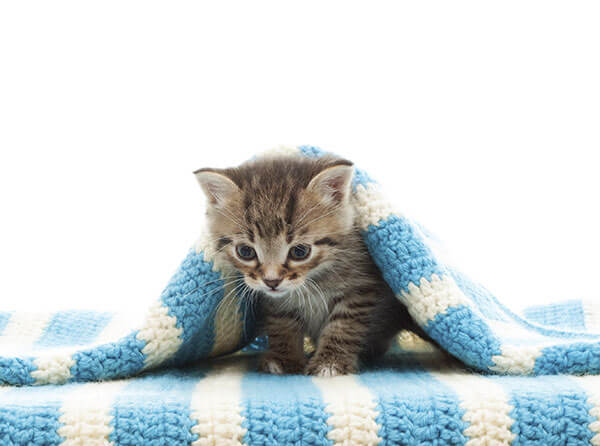Article originally published on Blue Buffalo. Refer to the original article here.

Adopting a kitten or just thinking it over? There’s probably nothing better than taking home a wide-eyed, velvet-nosed ball of fluff (hey, who’s rescuing who?) but even if you’ve had a kitten before, it’s wise to review the basics.
Best age to adopt
Separating kittens from their biological moms and siblings is best when they’re 10 to 12 weeks old. If the litter hasn’t had much human contact, however, it’s better to bring them home at six to seven weeks old.
As for personality, this may be one time when curiosity doesn’t kill the cat: look for an inquisitive kitten who’s playful, not shy. Above all, pick a cat-itude that complements all family members.
Pre-kitten prep
Before you introduce Kitty to her new surroundings, safely stow items she might chew, swallow or choke on. Keep tissues, paper towels, toilet paper, pens, pencils, rubber bands, jewelry, balloons, and small items out of paw’s reach. If you have other pets, be sure they’ve seen the veterinarian recently so they won’t be sharing an infection with their new sibling.
More cat-proofing tips:
- Anchor window cords, cap outlets and bundle electronic cords
- Call the Animal Poison Control Center (1-888-426-4435) for a list of deadly plants to avoid
- Lock acetaminophen (Tylenol) away; it’s deadly to felines
- Hide roach or ant traps
- Close toilet lids, washer and dryer doors
- Close kitchen and bathroom cabinets because household items like bleach, detergent, antifreeze can be very harmful
Kitty’s lair
Choose a secluded room, away from other furry family members, for Kitty to adjust to her new life. If sleeping is a problem, try the time-tested trick of wrapping a ticking clock in a blanket by her bed. Open her carrier and place it nearby along with her food, water bowls, litter box and toys.
Avoid toys with small, moveable parts that can detach easily and choke animals. Dangling string, yarn or ribbons may drive cats batty, but watch that they don’t tangle or choke Kitty. Small stuffed animals and trackballs make the best playthings because they’re safe and stimulate exercise.
You may have more fun watching Kitty play than she’ll even have playing, but you’ll also want to observe her behavior at rest. Sneak a peek at how she moves in and out of her carrier in her new room. If she dashes in fast, she may still need more time to acclimate. If she saunters, you’ll know she’s ready to explore the rest of the house.

Meet the kin
A kitten can take up to two weeks to fully relax, so limit human interactions those first few days, then introduce her to family members slowly, one at a time, so she learns everyone’s touch.
Teach young children how to hold kittens with one hand behind their front legs, the other under their hindquarters. They also need to know that tugging at Kitty’s scruff, ears or tail is a no-no. And, though tantrums may ensue, kids four and under shouldn’t be handling Kitty at all, especially unsupervised.
Other household pets will sniff out their new sibling immediately, so introduce Kitty on her turf; don’t let her have free run of the house because that’s their territory.
Resident cat(s) can check Kitty out briefly while you observe. Should a hissy fit erupt, separate the siblings immediately and try again in a few days. As for Fido, be sure he’s properly leashed when he meets her, plus keep Kitty from running off, otherwise he may think it’s time to give chase.
If all siblings play nice, reinforce their good behavior with well-deserved treats. Also, never leave playtime unsupervised until Kitty is full-grown.
Can we stalk?
Cats have a primal instinct to explore so, at first, let Kitty roam one room at a time. Place her open carrier in the room she’s investigating in case she gets nervous and needs a hasty retreat. Let Kitty explore while you quietly watch closely in case she hides under a bed or scoots under the sofa. If she starts kneading your expensive duvet, put her back on the floor gently to teach her that your bed is off limits.
Open 24 hours
Kittens need lots of nutrients and energy—about two to three times that of cats because they grow so fast. 30% of their total energy should come from protein so be sure to feed them food specifically formulated for them that first year, such as dry kitten food or nutrient-dense kitten-formula canned food. The rest of Kitty’s diet should come from high-quality dry and wet foods, packed with protein and essential amino acids to help give her wholesome nutritional support.
Unlike pups, kittens don’t wolf down all of their food in one sitting so you can conveniently set up an all-day/night buffet. Dry food is convenient because it won’t spoil if it sits for a while; be sure fresh water is always available, too. You’ll also want to keep siblings like Fido from stealing Kitty’s food by putting her bowl in an area others can’t reach.
Mind her business
Kittens instinctively dig to bury their waste, but they still may need some nudging when it comes to doing their business. After Kitty’s finished eating, or had her catnap, introduce her to her litter box. If she doesn’t take to it naturally, guide a front paw and simulate digging. You may need to repeat this process at regular intervals.
For the first few weeks, provide Kitty with the same food, feeding schedule and litter she had before the adoption. You can slowly transition to other litter products and food after she’s adjusted.

First check-up
It’s wise to pre-schedule a veterinarian visit prior to bringing Kitty home so she’s checked within a few days of her arrival. Your vet will look for ear mites, fleas, deworm her, plus give her all the necessary shots and vaccinations.
He/she will also determine the best time to spay or neuter, which can be as early as eight weeks old. Spaying helps protect Kitty from the risk of mammary, uterine and ovarian cancers, and neutering reduces the male’s risk of prostate cancer. Added bonus: you’ll enjoy a “spray-free” home and less odorous litter box cleanup.
Here Kitty, Kitty
Canines aren’t the only ones who benefit from training. Just like puppy pre-school, kitty etiquette has caught on and you can actually train your cat to come when you call. Plus, if you have more than one kitten, you may need to nip roughhousing behavior in the bud.
Above all, enjoy every precious moment with the latest member of your extended family!
Kitten Must-Haves
- Food and water bowls
- Course-textured 3 ft. high column/post for stretching/scratching
- Fun, safe toys to promote exercise (e.g., wands, balls, “treat” dispensers)
- Cat bed lined with a warm blanket or towel
- A grooming brush/nail clipper
- Cat carrier
- ID tag or implanted microchip. Even if Kitty will be queen of the castle, you want to be ready if she sneaks out. A safety collar with an ID tag can bring her home safely.
* This blog is designed to be a community where pet owners can learn and share. The views expressed in each post are the opinion of the author and not necessarily endorsed by Pawjourr. Always consult your veterinarian for professional advice.
